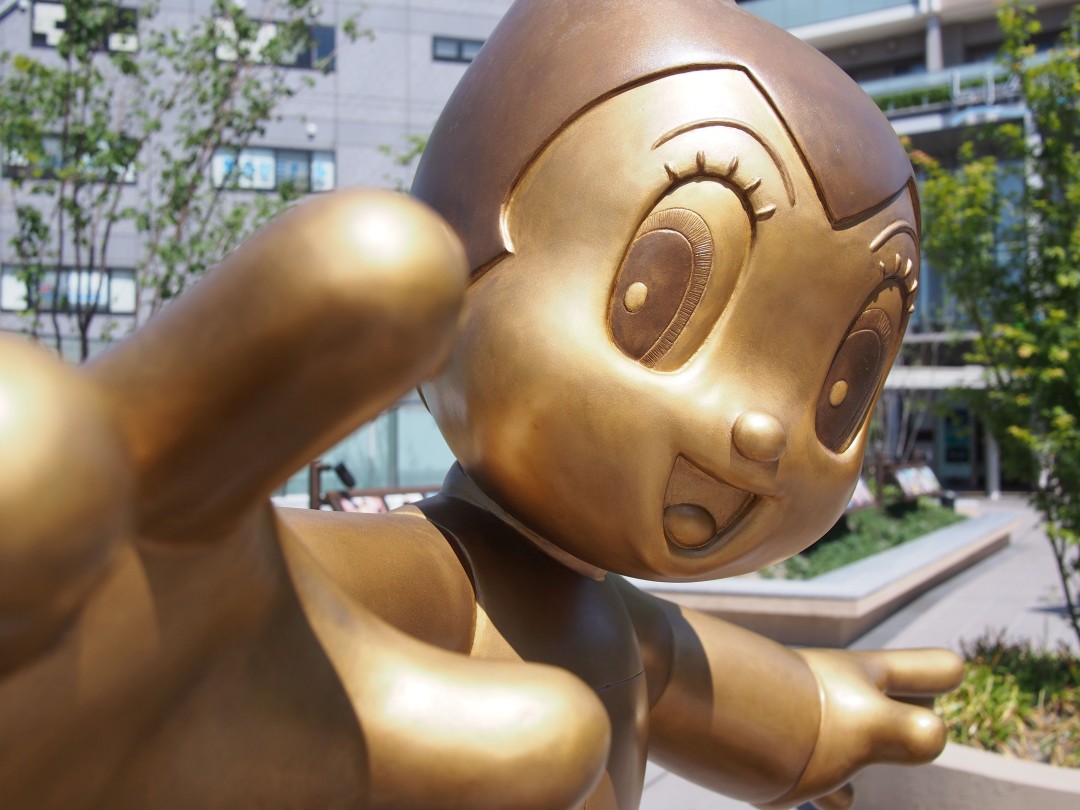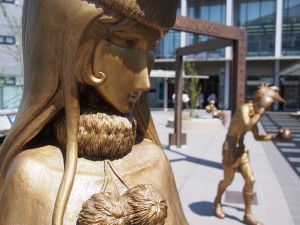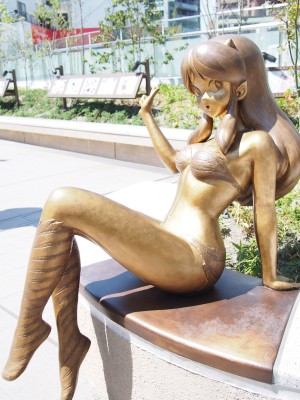The Holy Land of Nerima
December 26, 2015 · 1 comment
By Andrew Osmond. Pictures by Carlos Nakajima.
 Anime tourism is big business in today’s Japan. Around the country, local governments are savvy to the fact that if you can link your neighbourhood to a popular comic or cartoon, then the fan tourists will come. One way is to present your hometown in an anime, so its viewers will come to the real place as a pilgrimage. Such places are mock-reverently called ‘Holy Lands’: Ikebukuro in Durarara!!, Shinjuku in The Garden of Words (they’re both districts in Tokyo) and even London in the K-ON! film.
Anime tourism is big business in today’s Japan. Around the country, local governments are savvy to the fact that if you can link your neighbourhood to a popular comic or cartoon, then the fan tourists will come. One way is to present your hometown in an anime, so its viewers will come to the real place as a pilgrimage. Such places are mock-reverently called ‘Holy Lands’: Ikebukuro in Durarara!!, Shinjuku in The Garden of Words (they’re both districts in Tokyo) and even London in the K-ON! film.
But now there’s a new tactic; to build statues of anime heroes in places that have some connection to them. An article in the Asahi Shimbun newspaper reports this growing trend round Japan, with statues of all sorts popping up, from demon boys to football heroes. A member of Osamu Tezuka’s old Mushi studio reflected how times have changed from when he proposed an Astro Boy statue in the 1980s. “At the time, no local community was serious about constructing a prominent stature of a cartoon character,” he said. “There was opposition to the plan, saying it would make the city a laughing stock.”
Now the Mushi Studio’s one-time home, Nerima in northwest Tokyo, hosts its own anime statues. For a decade, Nerima has promoted itself as the ‘Cradle of the Japanese Animation’ and while learned authorities might disagree, it’s certainly a crucial part of the medium’s development. As well as Mushi, Nerima was (and is) home to Toei Animation, the biggest anime studio of all, and the longest-lived. Today it makes One Piece, and new versions of its other giant franchises: Dragon Ball, Sailor Moon, Saint Seiya. Back in the 1950s and 1960s, it was making pioneering cartoon features like Hakujaden: Legend of the White Serpent (1958).
Toei was also competing with its rival Mushi, founded by Osamu Tezuka. The Nerima upstart was breaking into TV with toons like Astro Boy and Kimba the White Lion. Tezuka’s Astro Boy is one of the characters represented in Nerima in bronze, rising up on a cloud of smoke.
 Another statue depicts Joe Yabuki, the star of a pre-Rocky boxing saga called Tomorrow’s Joe. As with most sporting anime, it’s not well known in Anglophone territories, but it was a huge icon in Japan. Like Astro Boy, Joe was animated by the Mushi studio on TV, based on a manga by Ikki Kajiwara and Tetsuya Chiba.
Another statue depicts Joe Yabuki, the star of a pre-Rocky boxing saga called Tomorrow’s Joe. As with most sporting anime, it’s not well known in Anglophone territories, but it was a huge icon in Japan. Like Astro Boy, Joe was animated by the Mushi studio on TV, based on a manga by Ikki Kajiwara and Tetsuya Chiba.
Then there’s a twin statue featuring an already statuesque lady of the cosmos, Maetel, along with her homely young boy companion, Tetsuro. If you’re a fan of Leiji Matsumoto, then you’ll know Maetel and Tatsuro are the main characters of his epic manga Galaxy Express 999. Toei animated it in 113 parts from 1978 to 1981, and also retold it in feature films. Toei has a long-standing partnership with Matsumoto; the studio handled his Space Pirate Captain Harlock franchise over four decades, including the recent CGI film.
 Matsumoto lives in the Nerima area, as does Rumiko Takahashi, the woman creator of the last character in statue form. This is Lum, the bikini-clad alien heroine of Urusei Yatsura. Although the 1980s TV version was made by a non-Nerima studio, Pierrot, Takahashi still centred the story around Nerima; her other strip Ranma ½ is set there too.
Matsumoto lives in the Nerima area, as does Rumiko Takahashi, the woman creator of the last character in statue form. This is Lum, the bikini-clad alien heroine of Urusei Yatsura. Although the 1980s TV version was made by a non-Nerima studio, Pierrot, Takahashi still centred the story around Nerima; her other strip Ranma ½ is set there too.
By the way, Takahashi is not the only author to use Nerima as a setting. Recent anime examples include Nerima Daikon Brothers and the grisly Tokyo Ghoul. The recent live-action gangster film-slash-rap musical Tokyo Tribe turned the peaceful district into the home of the murderous Nerimamotherf******!
Matsumoto and Takahashi were both on hand to unveil the Nerima statues this April; you can see the images here. If you’re in Tokyo and want to pay respects to Astro, Joe, Lum, Maetel and Tetsuro, then the easiest way is to go to from Ikebukuro, as seen in Durarara!! (mind the headless biker). Take the private overground Seibu Ikebukuro line and get out at Oizumi-gakuen station. The statues are just outside on a raised pedestrian deck outside the north exit.
And finally… The Nerima figures aren’t the only statues of famous Japanese fantasy characters which have gone up recently. There’s also a representation of one of Tokyo’s biggest residents – well, his horrid head at least – in Shinjuku. If you’re a disciple of the city-stomping Godzilla, you can find him on the Shinjuku Toho Building in Kabukicho. Reportedly it contains a hotel offering ‘Godzilla View Rooms,’ if you want to fall asleep to the sight of a roaring kaiju, and a Godzilla Room paying tribute to the G’s films. But actually, the head is most effective if you see it from further away… We wonder how many Tokyo tourists get a rude shock every day?
Andrew Osmond is the author of 100 Animated Feature Films. Nerima Daikon Brothers will be released by Anime Ltd soon.
anime, Godzilla, Japan, Leiji Matsumoto, Mushi, Nerima, nerima daikon brothers, Toei, Tomorrow's Joe, tourism, urusei yatsura
Adam
December 26, 2015 9:36 pm
Thanks for the article. I live in Nerima so I'll be checking out the statues soon. One small detail: Nerima is in northwest Tokyo, not southwest.